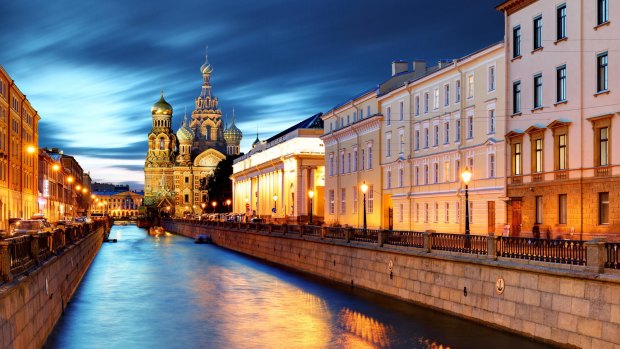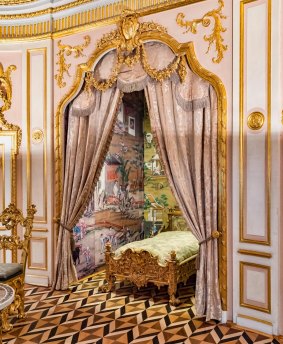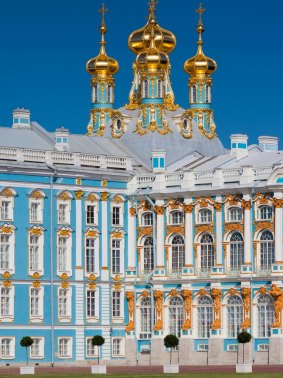This was published 4 years ago
Why river cruises are a compelling introduction to Russia
By Sally Macmillan

The Church of the Saviour on Spilled Blood.Credit: Alamy
Like many other first-time visitors, I'd always thought Moscow's Red Square's name had something to do with the Bolsheviks … but no. The colour red is significant in Russian culture, not in the "reds under the beds" sense but because the Russian word for red, krasnyi, originally also meant beautiful or good.
I learn this and much more while looking around a 19th-century house on Kizhi Island, one of a collection of historic wooden buildings that make up an unusual open-air museum in the middle of Lake Onega. Our guide shows us the "red corner" in the farmhouse, dedicated to the householders' favourite icon (religious artwork), and says they still feature in many modern Russian homes.
Kizhi Island's most photographed building is the Transfiguration Church, constructed in 1714 from pine logs without a single nail and featuring 22 domes. Even though temporary scaffolding surrounds its upper levels when we visit, the church looks like something out of a fairytale on this misty autumn morning.

Peterhof Palace.Credit: Alamy
The deceptively simple architecture, which dates back to the 16th century, contrasts starkly with the extravagant palaces and monuments of St Petersburg and Moscow, the two cities that bookend our 13-day river journey.
St Petersburg is a dazzling visual feast. We have three days of intense sightseeing to take in the most important cultural landmarks – and even then, we still have to make some tough calls to make. A half-day boat trip along the network of canals and rivers is a wonderful introduction to the city's golden-domed churches, waterfront parks, sumptuous mansions and ornate palaces.
A tour of the spectacular Winter Palace, part of the Hermitage museum complex, is top of the list. It houses one of the world's biggest collections of art and antiquities as well as a sizeable population of cats who are as integral to the Palace's history as the priceless artworks.

Catherine Palace.Credit: Alamy
Catherine Palace, a lavish confection about 30 kilometres south of the city, is another eye-opening monument to the excessive lifestyle of the Romanov dynasty. Other musts include Peterhof Palace, the Church of the Saviour on Spilled Blood, Peter and Paul Fortress, the Fabergé Museum and, if you've booked ahead, a ballet or opera at the Mariinsky Theatre.
We take off from St Petersburg and spend the next five days travelling along hundreds of kilometres of rivers, across the vast Ladoga and Onega lakes, and into the Volga-Baltic Waterway that leads into Moscow.
At Mandrogy, a reconstructed traditional village on the banks of the River Svir, a group of women from the ship take a Russian banya. This thoroughly invigorating experience is similar to a Swedish sauna, from being hit by birch twigs wielded by banya attendant Dmitri to being drenched in buckets of icy river water.
Further downriver, visits to the medieval Kirillo-Belozersky Monastery on the shores of Lake Siverskoye and a local high school paint pictures of old and new Russia. The fortress-like monastery was one of the richest landowners in Russia during the 17th century and some of its stunning icons are close to 600 years old.
At the high school, students perform folk dances and tell us about their lives. Despite hardships such as a lack of running water in many of their homes, the teenagers are keen to study – how many 14-year-olds in Western schools can speak another language fluently?
Calls to the picturesque Golden Ring cities of Yaroslavl and Uglich precede our arrival in Moscow. We wander streets lined with elegant houses and onion-domed churches, check out a local produce market and shop for souvenirs at street stalls.
We get around Moscow on foot and by metro and it is surprisingly easy to navigate. About 40 of the metro stations, "palaces for the people" built in the Stalinist era, are adorned with chandeliers, sculptures and paintings.
Among the many famous attractions – St Basil's Cathedral and the GUM department store in Red Square, the Kremlin Armory, the Bolshoi Theatre, Gorky Park, Novodevichy Convent, the Cathedral of Christ the Saviour – one of the most popular, and bizarre, is Lenin's Mausoleum. If you're keen to see the former leader's embalmed body, bear in mind that opening hours are limited, queues are long, and every other year the mausoleum is closed while scientists re-embalm him. And that's a whole other story.
This article appears in Sunday Life magazine within the Sun-Herald and the Sunday Age on sale June 9.
Sign up for the Traveller Deals newsletter
Get exclusive travel deals delivered straight to your inbox. Sign up now.